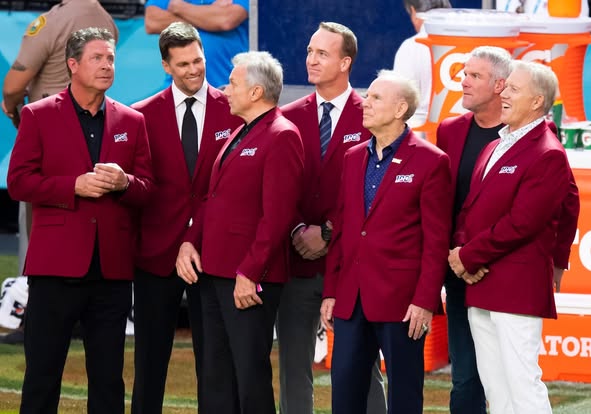Joe Montana Makes an Unprecedented $50 Million Donation to the Notre Dame Football Program
Joe Montana’s $50 million donation to the Notre Dame Football Program is an extraordinary gesture that speaks volumes about his deep connection to the university, the football program, and his desire to give back to a school that played a pivotal role in shaping his career. This donation, one of the largest ever given to a collegiate sports program, carries immense significance not only in the context of Notre Dame’s rich football tradition but also in the larger landscape of sports philanthropy. It represents a milestone that sets a new precedent for how former athletes can contribute to their alma maters, enhancing the legacy of both the individual and the program. Let’s explore the impact of this unprecedented donation, its implications for the Notre Dame Football Program, and the broader significance it holds.
The Background: Joe Montana’s Legacy at Notre Dame
Joe Montana’s relationship with Notre Dame is a storied one. The quarterback played for the Fighting Irish from 1975 to 1978 under legendary head coach Dan Devine. During his time at Notre Dame, Montana was part of the team that won a national championship in 1977, a defining achievement in the university’s football history. His play in the 1977 season was instrumental in cementing his reputation as one of the best quarterbacks in the country. Even though he didn’t start every game during his college career, Montana’s poise, leadership, and ability to deliver in clutch moments made him a household name.
Montana’s success at Notre Dame, however, was just the beginning. After being drafted by the San Francisco 49ers in the third round of the 1979 NFL Draft, he went on to have an illustrious career in the NFL. Known for his incredible performances in Super Bowls, Montana earned the nickname “Joe Cool” due to his calm demeanor in the most high-pressure situations. With four Super Bowl victories, three Super Bowl MVPs, and a place in the Pro Football Hall of Fame, Montana solidified his legacy as one of the greatest quarterbacks in football history.
Throughout his NFL career, Montana maintained close ties with his alma mater. He regularly visited Notre Dame’s campus and supported the team from afar, attending games and events as a guest of honor. This enduring connection between Montana and Notre Dame laid the foundation for what would eventually become a transformative gift to the football program.
The $50 Million Donation: A Game-Changing Moment
In April 2025, Joe Montana announced his donation of $50 million to the Notre Dame Football Program. This unprecedented gift sent shockwaves throughout the world of collegiate athletics. The donation is one of the largest ever made by a former athlete to a college program, and it is being hailed as a game-changer in terms of the impact it will have on the future of Notre Dame football.
The donation is particularly significant because it comes at a time when college football is undergoing a period of profound change. With the rise of the NIL (Name, Image, and Likeness) era, college programs are scrambling to find ways to remain competitive in an increasingly commercialized environment. Montana’s gift not only serves as a financial boon for the program, but it also sends a message that the tradition of college football, especially at storied institutions like Notre Dame, still has the power to inspire greatness.
Montana’s donation is structured in such a way that it will be used to fund a variety of initiatives within the football program. This includes upgrades to the facilities, enhanced training and development resources for athletes, and increased support for the coaching staff. In addition, the gift will be used to establish a new scholarship fund to ensure that talented athletes from all backgrounds have the opportunity to attend Notre Dame and play for the Fighting Irish.
One of the most exciting aspects of Montana’s donation is its potential to elevate the program to new heights. With this financial backing, Notre Dame will have the ability to attract top-tier talent, enhance its recruiting efforts, and compete at an even higher level in the college football landscape. The funds will help ensure that the Fighting Irish remain a perennial contender for national championships, further solidifying their place among the elite programs in the sport.
The Impact on Notre Dame Football
Notre Dame football has long been one of the most prestigious programs in college football, with a rich history that includes numerous national championships and a string of legendary players and coaches. However, in recent years, the program has faced increasing competition from other top-tier schools, particularly in terms of recruiting and facilities. Montana’s $50 million donation comes at a crucial time when Notre Dame is working to maintain its relevance in the ever-changing landscape of college football.
The infusion of $50 million will provide Notre Dame with the resources necessary to upgrade its facilities and compete with other programs that have seen significant investments in recent years. For example, rival schools like Alabama, Clemson, and Ohio State have poured substantial amounts of money into their athletic facilities to create state-of-the-art environments for their student-athletes. Montana’s donation will enable Notre Dame to make similar upgrades, ensuring that the football program remains competitive not just on the field, but in the recruitment of top talent.
One of the primary areas where this donation will have an immediate impact is in the training and development of student-athletes. The new funds will go toward expanding the strength and conditioning facilities, building additional indoor practice fields, and enhancing the medical and wellness resources available to players. These investments will not only help improve the physical performance of the athletes but also ensure their long-term health and well-being.
Additionally, the donation will allow for the expansion of the coaching staff and the hiring of additional support personnel. This is particularly important in an era where coaching staffs are becoming larger and more specialized, with positions dedicated to areas such as analytics, nutrition, and mental health. By expanding the coaching staff, Notre Dame will be able to provide its players with a more comprehensive and personalized experience, giving them the tools they need to succeed both on and off the field.
Perhaps the most important aspect of Montana’s gift is the establishment of a new scholarship fund. This fund will provide financial assistance to talented student-athletes who may otherwise have been unable to afford the cost of attending Notre Dame. With the rising costs of tuition and other expenses, scholarships have become a critical factor in attracting the best athletes to a program. By creating this fund, Montana is ensuring that future generations of athletes will have the opportunity to experience the same educational and athletic opportunities that he did during his time at Notre Dame.
A New Era of Philanthropy in Sports
Montana’s donation to Notre Dame is part of a larger trend of former athletes giving back to their alma maters and supporting the growth and development of college sports programs. While donations from former players are not new, Montana’s gift stands out for its size and its potential to reshape the way college football programs are funded.
In recent years, there has been a growing movement among former athletes to invest in the future of collegiate sports. This is especially true in football, where the financial stakes have never been higher. As the sport becomes more commercialized and the arms race for top-tier talent escalates, the need for substantial financial backing has become increasingly apparent. Montana’s $50 million donation sets a new standard for how much former athletes can contribute to the future success of their alma maters.
The motivations behind such donations are multifaceted. For some athletes, like Montana, the desire to give back to the school that helped shape their careers is deeply personal. For others, it may be a way to ensure that future generations of athletes have access to the same opportunities they did. Regardless of the reasons, the impact of these donations is undeniable. They provide programs with the resources they need to remain competitive and continue to produce top-tier talent.
Montana’s donation also highlights the growing role of philanthropists in college athletics. With the rise of NIL and the increasing commercialization of college sports, donors have become more important than ever in shaping the future of programs. The ability of wealthy individuals to influence the trajectory of a program through their financial support is a powerful tool, and Montana’s gift is a prime example of how former athletes can use their wealth and influence to make a lasting impact.
Conclusion: A Lasting Legacy
Joe Montana’s $50 million donation to the Notre Dame Football Program is a landmark moment in the history of college athletics. It is a testament to the enduring bond between Montana and his alma mater, and it serves as a powerful reminder of the role that former athletes can play in shaping the future of their programs. This donation will have far-reaching effects on the Notre Dame football program, providing the resources necessary to compete at the highest level and ensuring that future generations of student-athletes have the opportunity to experience the same success that Montana enjoyed during his time at the university.
In a broader sense, Montana’s donation represents a new era of philanthropy in sports. It sets a precedent for how former athletes can give back to their programs and provides a model for others to follow. As college athletics continue to evolve and face new challenges, donations like Montana’s will play a crucial role in ensuring that the traditions and legacies of programs like Notre Dame remain intact for years to come.



